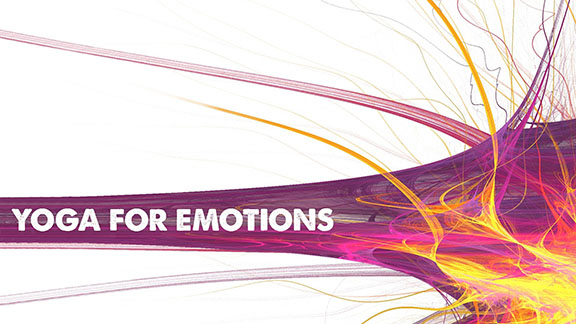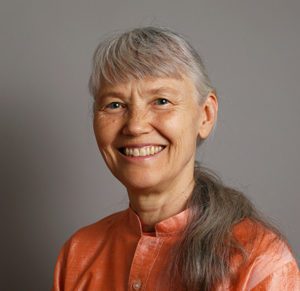 Integral Yoga master teacher Swami Vidyananda’s workshops on Yoga and the emotions explore Integral Yoga techniques that bring greater harmony within oneself and to one’s relationships. These workshops use Hatha Yoga and meditation, as well as sacred imagery, cognitive restructuring through Raja Yoga and other Yoga tools. In this interview, Vidyanandaji illustrates how the multimodal approach of Integral Yoga is a very simple, yet powerful approach to mind-body healing and improved emotional balance.
Integral Yoga master teacher Swami Vidyananda’s workshops on Yoga and the emotions explore Integral Yoga techniques that bring greater harmony within oneself and to one’s relationships. These workshops use Hatha Yoga and meditation, as well as sacred imagery, cognitive restructuring through Raja Yoga and other Yoga tools. In this interview, Vidyanandaji illustrates how the multimodal approach of Integral Yoga is a very simple, yet powerful approach to mind-body healing and improved emotional balance.
Integral Yoga Magazine: What is the Integral Yoga approach to emotional well-being?
Swami Vidyananda: We approach the emotions through all levels of our being (the koshas): the body, breath, senses and intellect. We start with the body. Our emotions, we know, affect our health. Negative emotions show up in our body as tension, blocked energy, body armoring and physical discomfort. The poses essentially massage the body and so release emotional holding patterns. Over time, we let go of old painful emotions by releasing the memory of them that we hold in the body. This approach is a different from remembering old stories of how we got hurt. As Joseph Campbell said, “The Eastern approach to psychotherapy is biologic, not biographic.”
When I started practicing Hatha Yoga, many years ago, I had a couple of years when the practice was always joyful. Then I started to notice that I would be distracted by angry thoughts during my asanas. I wondered if I was doing something wrong in my Yoga practice. The anger would bubble up, and I would use Raja Yoga to analyze the anger during my meditation after the poses. I asked myself, “What am I attached to that’s making me angry? Will getting that thing make me permanently happy?” And after a while, the anger subsided.
I eventually realized that it was old anger that I had stuffed down for years that was gradually being released through my practice. I even had memories of childhood injustices that still distressed me, when I remembered them. So my Hatha Yoga practice was bringing them up, but also helping me to let go of them. Over the years I can see how the combination of Hatha Yoga and meditation gradually brought up old unresolved emotions and provided a way to integrate those energies in my mind and heart. It’s a long process, but so worth it when we realize that the manomaya kosha (emotional layer) goes with us into future incarnations.
IYM: Would all types of physical exercise have the same effect?
SV: They can, yes, but there’s something unique about classical Yoga traditions. It’s not just movement but the awareness that makes it Yoga. We tend to push painful emotions out of our awareness, along with the physical distress they cause. This can lead to depression and ultimately illness. In Integral Yoga Hatha poses, we move slowly so we can be conscious of what we feel at every phase of the movement. We start to study our use of prana, or energy. Am I using too much prana by straining or forcing my way through tension? Or am I using too little by not going as far as I could in the posture? Where are my chronic holding patterns that block the natural energy flow in daily life? Can I let go of the patterns, open the flow and relax?
This is different than, for example, basketball, where the focus is on the ball, one’s team members, the basket, etc. In Yoga the focus is inside us, listening to the body and the breath, stretching while letting go. This is profoundly healing for the body and emotions.
In basketball, it’s easy to strain oneself because of being so focused on the game .In classical Yoga traditions we don’t strain. When we strain, our bodies feel pain, and we know to stop. If, however, our minds say, “No, I want this pose to be perfect and what I’m doing isn’t good enough,” two things happen: When we suppress what we are feeling in the body, we simultaneously stuff down the emotions as well. Straining re-enforces a negative emotional pattern, and having the thought that “This comfortable asana isn’t good enough” re-enforces a negative self-image.
With Integral Yoga Hatha, we learn to not strain; we learn to listen effectively to the messages from our bodies. Then we start to listen to our bodies in daily life also, to know when to rest, when to eat and when to move. That’s the foundation of a healthy lifestyle. When the body is healthy, it’s so much easier to be emotionally balanced too, because physical pain makes us emotionally cranky and depressed. So, not straining is a key component to the Integral Yoga Hatha class.
We do a balanced set of asanas. This includes warm-ups, backward bending postures, forward bends, inversions and twists. Backward bending stimulates the sympathetic nervous system, which makes us feel alert and strong, ready to face challenges. Forward bends stimulate the parasympathetic system, and this engenders the relaxation response. When we do backward bends and forward bends, we are alert and calm, fearless and self-nurturing. Inversions are very helpful for overcoming depression because the body is released from the normal downward pull of gravity. Physically we are helping ourselves to eliminate states of fear through the backward bends, anger through the forward bends and depression through inversions. The half spinal twist balances the ida and pingala, the masculine and feminine sides of the body.
IYM: How does deep relaxation affect the emotional body?
SV: During deep relaxation we work through each of the koshas. We alternately tense and release each part of the body to relax the physical body, or annamaya kosha. This is followed by mentally relaxing each part of the body. Swami Satchidananda (Gurudev) said, “Every cell of your body is under your conscious control, if you choose to exercise your mental mastery.” What a powerful teaching! You stand in the place of the witness and relax the body through your will. Next, we relax the vital energy level, or pranamaya kosha, by witnessing and relaxing the breath. Then, we relax the emotional layer, manomaya kosha, by watching our thoughts and feelings. Throughout this process, we stand in the place of the buddhi, or witnessing mind, at the level of the vijnanamaya kosha. When the outer levels of our being are relaxed, they no longer distract us. So the intellect can turn around, so to speak, and look within, where we experience our center of peace, at the anandamaya kosha.
We may start our practice or come into a hatha class beset with worries and problems, but after massaging the body with the hatha poses and systematically letting go in relaxation of identification with our external layers, we usually can feel the peace that is always inside us. We can tap into our divine emotion of bliss.
IYM: Some people seem to find it hard to relax during deep relaxation.
SV: Yes, sometimes the mind and the emotions are so agitated that they continue to draw the mind outward to our problems and worries. Gurudev said, if the mind is very agitated in meditation, go back to preparation (chanting or pranayama). The same is true for deep relaxation. If you find you get spaced out or restless, go back to tensing and releasing part by part. Then you can scan the body in great detail. Focus on what each finger is feeling, then the palm, the wrist and so on. Feel the weight of the body against the floor in each part—the back of the head, the shoulders, the back of the arms and so on. Stay very focused in physical sensation. The body becomes your anchor in the present moment. Gradually the body relaxes and, with it, the mind begins to calm down. Then inhale into each part of the body (in your imagination) and as you exhale say, “Let go.”
It can be very helpful to use a recorded deep relaxation when you’re practicing at home. Studies have shown that we relax most deeply with a live teacher and second best with a recording. It keeps us focused and helps lessen the tendency to drift off into sleep or day-dream.
IYM: What happens in the next part of an Integral Yoga class?
SV: We work directly with pranamaya kosha through the breathing practices or pranayama. When we breathe deeply there is a physiological reflex that tells our mind that we are safe, and we can relax. Sri Gurudev teaches us that there are ways to make this even more effective for the emotions by replacing a negative emotion with a positive one, using pratipaksha bhavana. For example, if you are troubled by angry feelings, during alternate nostril breathing, you can breathe in peace and breathe out anger. If you are depressed, breathe in cheerfulness and breathe out depression. You can use this technique for any troubling emotional state, and you will feel gradual but very concrete results.
One student (I’ll call him John) came to take our Teachers Training (TT) program. John fell in love with another trainee, but she was interested in someone else. During the program, he learned the technique of using deep breathing to cultivate more positive states. He was not feeling good about himself because he felt rejected by this woman. So, he began to do a practice of breathing in love and breathing out negative self-image and rejection. After a few weeks of this practice, out of the blue the other trainees started to tell him, , “John, you’re such a loving person.” After the TT the woman he was focused on lost interest in the other man, she and John got together. They’ve now been married for 15 years! That doesn’t mean that by doing this, someone will always fall in love with you [laughs], but the point was he actually began to feel differently and to attract the loving energy that complemented the love he was generating within himself.
About Swami Vidyananda:
 Swami Vidyananda has enjoyed many different roles in her life, including radio news reporter, translator for Swami Satchidananda, and video producer. She is a senior monk who has received training as a hospital chaplain. She has been teaching Integral Yoga since 1972. She is a versatile teacher, who helped develop the Integral Yoga Stress Management Teacher Training program. She specializes in workshops on stress management as well as Yoga and the emotions. Swami Vidyananda has taught in the US, Canada, Europe, India, and Australia. For more information, please visit: www.swamividyananda.com.
Swami Vidyananda has enjoyed many different roles in her life, including radio news reporter, translator for Swami Satchidananda, and video producer. She is a senior monk who has received training as a hospital chaplain. She has been teaching Integral Yoga since 1972. She is a versatile teacher, who helped develop the Integral Yoga Stress Management Teacher Training program. She specializes in workshops on stress management as well as Yoga and the emotions. Swami Vidyananda has taught in the US, Canada, Europe, India, and Australia. For more information, please visit: www.swamividyananda.com.

